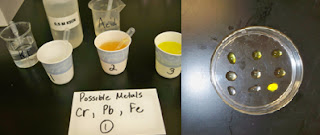1) What is the definition of poison?
 · A substance that, when introduced into or absorbed by a living organism, causes death or injury, esp. one that kills by rapid action.
· A substance that, when introduced into or absorbed by a living organism, causes death or injury, esp. one that kills by rapid action.2) Common poison sources
· Gases
· Anti-freeze
· Food
· Pesticides
· Drinks
· Medication
· Venom
· Cyanide
· Plants
· Metals
· Sugar
· Household chemicals
· Iodine
3) How do crime labs handle poison cases? What are some signs of poisoning?
· Scientists in labs can use several different chemicals and indicators to identify different types of poisons, such as:
o KSCN to test for iron
o KI to test for lead
o Acid to test for Chromate
o FE+3 to test for Cyanide
o Starch to test for Iodine
· Some signs of poisoning are:
o Pupil dilation
o Drooling
o Dry Mouth
o Altered heart rate
o Altered breathing rate
o Hyperactivity
o Drowsiness
o Rashes
o Confusion
o Hallucinations
o Cardiac arrest
Poison Identification Activity
1. Metals- if metals are ingested or put into the bloodstream it can be fatal to the recipient.
.5 M KSCN | KI | Acid | |
1 | Negative | Positive for Lead | Negative |
2 | Positive for Iron | Negative | Negative |
3 | Negative | Negative | Negative |
2. Sugar- sugar can be very harmful especially if the person has diabetes.

1 | 2 | 3 | |
Benedict Solution | Negative | Negative | Negative |
3. Ammonia- is a household chemical that can make someone go unconscious and when combined with bleach inhaling would be fatal.
Odor | pH less > 7 | PHTH is purple/pink | |
1 | Positive | Positive(11) | Positive |
2 | Negative | Positive (8.5) | Negative |
3 | Negative | Positive (8.5) | Negative |
4. Aspirin- if a large amount of aspirin is ingested the acid in the medicine can cause great harm to the body possibly ending in overdose.
pH <7 | BTB is yellow | |
1 | Positive (5) | Negative |
2 | Positive (6) | Negative |
3 | Positive (2) | Positive |
5. Cyanide- is an odorless poison that when ingested is fatal.








